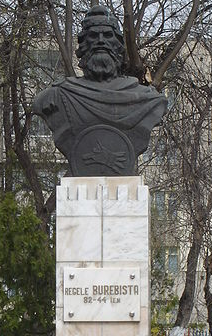| Burebista | |
|---|---|
 Statue of Burebista located in Călărași | |
| Dacian king | |
| Reign | 82/61–45/44 BC |
| Successor | Cotiso |
| Died | 45/44 BC |
Burebista (Ancient Greek: Βυρεβίστας, Βοιρεβίστας) was the king of the Getae and Dacian tribes from 82/61 BC to 45/44 BC. He was the first king who successfully unified the tribes of the Dacian kingdom, which comprised the area located between the Danube, Tisza, and Dniester rivers, and modern day Romania and Moldova. In the 7th and 6th centuries BC it became home to the Thracian peoples, including the Getae and the Dacians. From the 4th century to the middle of the 2nd century BC the Dacian peoples were influenced by La Tène Celts who brought new technologies with them into Dacia. Sometime in the 2nd century BC, the Dacians expelled the Celts from their lands. Dacians often warred with neighbouring tribes, but the relative isolation of the Dacian peoples in the Carpathian Mountains allowed them to survive and even to thrive. By the 1st century BC the Dacians had become the dominant power.
From 61 BC onwards Burebista pursued a series of conquests that expanded the Dacian kingdom. The tribes of the Boii and Taurisci were destroyed early in his campaigns, followed by the conquest of the Bastarnae and probably the Scordisci peoples. He led raids throughout Thrace, Macedonia, and Illyria. From 55 BC the Greek cities on the west coast of the Black Sea were conquered one after another. These campaigns inevitably culminated in conflict with Rome in 48 BC, at which point Burebista gave his support to Pompey. This in turn made him an enemy to Julius Caesar, who decided to start a campaign against Dacia. This plan fell through in 44 BC when Caesar was assassinated. Burebista himself was assassinated in a plot by the Dacian aristocracy at around the same time.
After Burebista's death, the empire he had created broke up into smaller kingdoms. From the reign of Tiberius to Domitian, Dacian activity was reduced into a defensive state. The Romans abandoned plans of mounting an invasion against Dacia. In 86 AD the Dacian king, Decebalus, successfully re-united the Dacian kingdom under his control. Domitian attempted a hasty invasion against the Dacians that ended in disaster. A second invasion brought peace between Rome and Dacia for nearly a decade, until Trajan became emperor in 98 AD. Trajan also pursued two conquests of Dacia. The first, in 101–102 AD, concluded in a Roman victory. Decebalus was forced to agree to harsh terms of peace, but did not honour them, leading to a second invasion of Dacia in 106 AD that ended the independence of the Dacian kingdom.